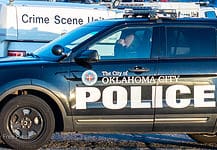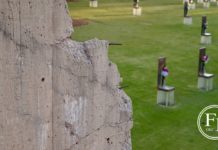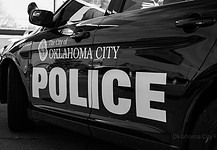Last Updated on September 25, 2017, 11:15 PM | Published: September 11, 2017
The 42nd annual Soul Bowl between the Millwood Falcons and the Oklahoma City Douglass Trojans is a good showcase for football talent every year.
In fact, OSU Head Coach Mike Gundy was on the edge of the field the first half looking over both schools’ talent.
Millwood ran away with the game turning in a 67 to 7 win against Douglass.
But the Soul Bowl represents much more, especially to African-American residents in the metro.
Both schools have deep and proud traditions of being positive learning environments for students from African-American culture.
Millwood pride
Millwood alum and Ward 7 Oklahoma City Councilman John Pettis was exuberant about the game.
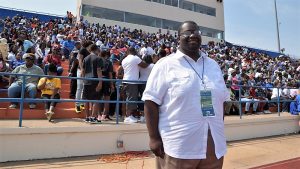
“You knew I would be here! You knew it!” he said laughing.
“To see the tradition still going on today is magnificent. You have two great schools that reside in northeast Oklahoma City – two majority African-American schools,” Pettis said.
Once Millwood was a small, 10.5 square mile rural district on the outskirts of northeast Oklahoma City.
But in recent decades, it has developed almost a private school feel because of black professionals and business owners buying and building into the district in the 1970s to the present.
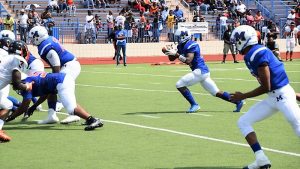
Pride runs deep in the district where black parents trust that big-school politics cannot disregard black culture and identity because of Millwood’s small, independent geographic area.
Nationally-known athletes like baseball great Joe Carter and track and field Olympian Gil Roberts are Millwood alums and contribute to the school’s pride.
Too big
Millwood crowds have continued to grow over the years to the point where this year’s Soul Bowl had to go somewhere other than Millwood’s stadium to accommodate the numbers when it was their turn to host.
“We outgrew Millwood,” said Superintendent Cecilia Woods-Robinson between moments of halted breathing each time Millwood’s quarterback threw a pass.

“We knew that even if we found a way to work at more safe seating in the stadium at our campus, we still wouldn’t have the parking.”k
That’s where historically-black Langston University near Guthrie stepped in and offered to let the Soul Bowl be held at their stadium, open because of the Langston team playing away that weekend.
“Langston’s been awesome,” she said. “They’ve been wonderful. I hope it will continue to work out that Langston is away on this weekend.”
“We’re hoping to continue to come up here when it’s our turn to host,” said Woods-Robinson.
Tradition!
The imbalance between the two teams didn’t stop the proud OKCPS Douglass Trojan fans from showing up with varying displays of the school’s black and orange colors.
Wanda Johnson (’71 grad), Careta Johnson (’73 grad) and Cheryl Frazier Mack (’75 grad) sat together and cheered for the Trojans the whole game, despite the score.
Free Press asked Careta Johnson why she’s back for another Soul Bowl.
“Because I’m a Douglass Trojan!” she said with a big smile.
When they were asked why they keep coming to the games, they each said “tradition!”

All three came with bright orange shirts, their finger nails and toenails done in orange, too. It’s what they do every year for their alma matter.
When the three were asked why they keep coming to the games, they said “tradition!”
But those loyal fans are not an exception.
Douglass has a long, proud tradition as a historic majority African-American school that thrived despite Oklahoma City’s checkered racial past of segregation and then federally-forced desegregation.
The Douglass Alumni Association reaches nationwide and continues to thrive at levels that would make some small colleges jealous.
And, it is not unusual to see one of the bright orange and black Douglass Alumni special Oklahoma car tags when driving the metro and beyond.
Deep history
Frederick A. Douglass High School, named after the famed black abolitionist, met first in a humble industrial building in Oklahoma City’s warehouse district, now known as Bricktown.
It then moved into a stately new building up the hill between northeast Fourth and Fifth streets facing N. High Avenue.

The student body grew to a point where it was obvious a new building and campus would be needed when just any high school could not take the overflow in segregated Oklahoma City.
The next and current campus was the old state fairgrounds at NE Eighth Street and Eastern Avenue, later renamed Martin Luther King Avenue.
Black business leaders and philanthropists helped to buy the property at Eighth and MLK and build the building with a full athletic campus that became the next Douglass High School in the 1950s.
Today’s Douglass Mid-High School is in a new building on the same property.
The old Douglass became Page-Woodson middle school before OKCPS closed it because the neighborhood no longer needed it.
This year a new residential development has preserved the beautiful bones of the former Douglass High School, and then Page-Woodson Middle School at Fourth Street and High Avenue and will open as “The Douglass.”
Founder, publisher, and editor of Oklahoma City Free Press. Brett continues to contribute reports and photography to this site as he runs the business.




